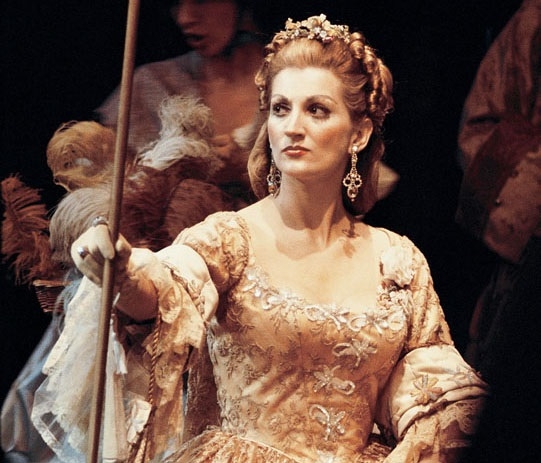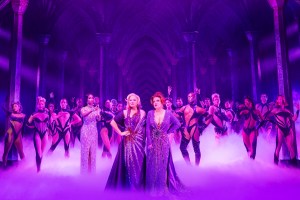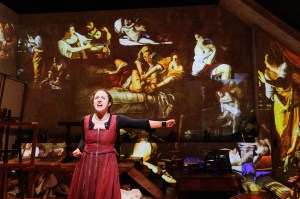People for (or Against) the People’s Opera
If NY City Opera is dead, long live — what?

(© The Phoenix)
New York City Opera has died. I grieve for its lost glories, mostly now long gone, but I’m not going to fill this essay with mournful memories. Instead, I think it would be wise to consider what sort of institution New York should create to replace NYCO. So we had better consider what City Opera achieved, why its existence was (and could again be) important to the city, and what went wrong to cause its shockingly speedy downward spiral, after more than six decades of comparative success.
For make no mistake, a replacement institution will certainly arise. The nonsense currently being spouted about New York City’s inability to support two opera companies, is, precisely, nonsense. New York City, bursting with wealth and artistic talent, can support any damn thing it needs; the trick is making it see that a given thing is needed. During the bulk of its 70-year life, City Opera was able to make a convincing case for that need. Inevitably it faced struggles, including financial struggles: No opera company in history has ever lived without them. Opera is expensive, and its success cannot be wholly measured at the box office. Unlike other kinds of theater production, it tends to require large ongoing forces. For those who act in spoken plays and vernacular musicals, a rotating repertory may be merely desirable as artistically nourishing — I personally see it as optimal — but for the singers of opera’s long, vocally arduous leading roles, repertory is a physical necessity.
Consequently, opera singers require either a short run or a schedule that gives them nights off to rest their voices. They require, too, a thoroughly rehearsed chorus and orchestra on whom they can rely. Anyone who has sat through the kind of hastily rehearsed, short-term opera productions with which small companies often favor us, with their pickup orchestras and catch-as-catch-can choruses, knows that the form, to be experienced at its best, demands skilled bands of artists in these categories, kept up to the mark by regular rehearsal, accustomed to working with each other, as well as with the same general body of soloists and roster of conductors. And these supporting bodies, too, need repertory for respite.

(© Beth Bergman)
Given the large complement of personnel it calls for, another key thing an opera company requires is, reasonably enough, a home: a physical space at least somewhat tailored to its needs. City Opera, in fact, was born, along with the other original constituents of New York City Center, out of the existence of a vacant building: The city had acquired, for nonpayment of taxes, the long-empty “Mecca Temple,” built in 1923 by the fraternal order familiarly known as the Shriners. With its bloated shape and extravagant gaudy Orientalist decor, the building was a comically old-fashioned white elephant from the outset. Its absurd excess was part of its charm, defusing any pompous solemnity that could make the audience feel imposed upon. This supplied exactly the right ambiance for a “people’s opera”: The event onstage was there for your pleasure, at a price you could afford, never attempting to compel you to live up to the implied aspirations of the surrounding architecture.
This populist concept, though increasingly lost sight of in NYCO’s later phases, was central to its mission: to make opera accessible, in both the economic and the aesthetic sense of that word, to every New Yorker. And this was explicitly taken not to mean condescension. What it did mean, in practice, was: low-priced tickets; performances of all but the best-known standard works in English; young, lively, artistically alert singers and stage directors; and a range of works that offered, on the flexibility of a low budget, an excitement that contrasted sharply with the caution that the more expensively cushioned Metropolitan Opera necessarily had to exercise.
Under all of its artistic directors, but particularly during the long and splendid tenure of Julius Rudel (1957-79), NYCO varied its Fausts, Carmens, Rigolettos, and Bohèmes with old treasures and new discoveries from Europe, operas that had either fallen out of the Met’s repertoire or had never made their way into it, being thought too intimate, too marginal, or too risky. The list of NYCO’s U.S. or New York premieres is a golden one: Strauss’ Ariadne auf Naxos and Capriccio, Poulenc’s Dialogues of the Carmelites, Britten’s Turn of the Screw, Korngold’s Die Tote Stadt, Janáček’s Cunning Little Vixen, Busoni’s Doktor Faust.
Most of all, though, City Opera served its people by evolving an American identity. It happily welcomed ideas, artists, and works from Europe — not doing so would have been damned foolish — but it never followed them slavishly. It made up its own mind about what was worth importing, and it ensconced its choices in a context of what Americans had achieved and could achieve.
Nurturing multiple generations of gifted American singing actors, it commissioned many new American operas, while rescuing many earlier works, especially those that had had to fight their way to recognition through Broadway’s commercial system. Gershwin’s Porgy and Bess, Blitzstein’s Regina, and Weill’s Street Scene became NYCO signature pieces, joining the newer works it nursed into popularity, like Carlisle Floyd’s Susannah, Douglas Moore’s Ballad of Baby Doe, Robert Ward’s The Crucible, and Jack Beeson’s Lizzie Borden.
Granted, many of these works were cast in a tonal idiom that the era’s culture snobs tended to look down on as somewhat old-fashioned. Shrugging off their sneers, the company, unperturbed, put higher-risk works like Hugo Weisgall’s austerely 12-tone Six Characters in Search of an Author and Leon Kirchner’s Lily, with its harsh Bergian Sprechgesang, into the rep, cheek by jowl with Floyd and Moore, Tosca and La Traviata. When City Opera said it was for everybody, it meant everybody. But I’ll say more about this, about the company’s downfall, and about what might follow it, next week.

(© Beth Bergman)
Click here to read part II of this "Thinking About Theater" column, which appeared on Friday, October 25.










